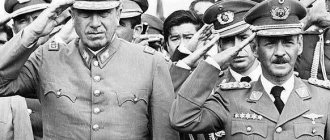tags:
Man, Ability, Activity, Orientation, Social, Psychological, System, General
8
Purpose: to consider the elements of personality structure and their properties.
Tasks
- determine the whole in the personality structure;
- consider its elements;
- characterize the characteristics of the personality traits of each substructure and their properties;
— consider the path of their formation;
— to form the concept of personality as a dynamic formation.
What is personality?
Not only psychologists deal with issues of personal characteristics; the problem is studied by teachers, philosophers, even criminologists, because the perception of the environment is based on the individual’s understanding of different areas of information. Having realized the phenomenon of “personality,” a person gets the opportunity to adjust his behavior in the sphere of interaction with other members of society.
Despite the fact that psychologists of the past and present use different words to denote the fundamental concept of psychology, the fundamental essence of the formulation does not change:
“Personality is the totality of the psychological characteristics of an individual. They form a stable system of individual human behavior, which is manifested in actions, self-esteem, and evaluation of the actions of other members of society.”
For a correct understanding, psychologists operate with three main concepts: individual (uniqueness), individuality (personalization), man (supreme being). In order for an individual to develop into a personality, he will need proficiency in speech; without the help of intellectual and sociocultural skills, it is difficult to adapt to society.
Motivational-need sphere as the basis of personality
Needs are the driving force of a person’s activity.
- Need is the body’s need for certain conditions, without which life is impossible.
- Motive is an objectified need.
- A set of motives aimed at a goal is motivation.
The need to understand the world is the most important for an individual. It frees a person from the captivity of fears, misunderstandings and superstitions, and allows him to be the creator of life.
Other spiritual needs are no less significant for the individual:
- in aesthetic pleasure;
- in labor;
- in social activities;
- in communication.
The development of needs (from lower to higher) is a condition for personality development.
Personality structure
The essence within society is high results of activity for the benefit of society. Knowledge of the stages of human development makes it possible to understand the motivation of actions and predict his further behavior.
Psychologists of different times tried to structure the baggage of the main aspects of the formation of individuality. In modern psychology there is still no single view of the psychological structure of the individual.
Personality structure according to Freud
In the theory of Sigmund Freud, personality represents a self-contained individuality, developing according to the laws of society, but opposing it. The source of activity becomes the sexual direction, and the phenomenon of subconscious attraction is the basis of the 3-component personal structure.
- ID. The sphere is designated by the concept “it”, contains the constitutional qualities of the individual, received by him by inheritance. The package of basic instincts is dominated by the sexual.
- Ego. The sphere is associated with one’s own “I”; it is a mental apparatus for an individual’s contact with reality. The level of consciousness is occupied with self-preservation, the Ego contradicts the core of the Id.
- Super Ego. The sphere manifests the moral part of the self, which controls the activities and thoughts of the Ego. The super ego imposes idealistic principles as opposed to realistic ones.
S. Freud's psychodynamic concept has many supporters; they perceive the theory enthusiastically. At the same time, opponents of the psycho-sexual approach to explaining human behavior reject the foundations of Freudianism.
Personality structure according to Rubinstein
Personality in psychology is the harmony of the trinity for interaction with the world. S. Rubinstein developed a version of the methodological platform; the formation of a personal structure is represented by 3 blocks.
- Orientation with a set of needs, beliefs, motives of behavior.
- A block of knowledge with skills for understanding the world, as well as acquiring skills.
- The individual typological component forms the uniqueness of the individual.
For the adequate functioning of an individual within society and ensuring his psychological health, it is necessary that all components of the personality work together. The unity of the personal core is ensured by the motives of conscious actions, taking into account unconscious tendencies (motives).
Personality structure according to Jung
In the analytical theory of Carl Jung, the personal core is represented by an integral conglomerate of the psychological system. If the spheres of Freudianism lower the researcher to the origins of the carnal causes of mental conflict, then the postulates of the analytical system of his colleague Jung elevate the potential of the individual.
It also includes three main components:
- Ego. Center of consciousness with thoughts, sensations, memories for awareness of one’s holistic identity.
- The area of the personal unconscious is a set of repressed memories and experiences.
- The basis of the collective unconscious is made up of universal models of perception (archetypes).
The concept of the genius follower of Freud determines the development of personality by the desire for a holistic image through the use of innate (individual) characteristics. The foundation of the structure is represented by two types of psychological attitudes.
Every person has a personal orientation towards introversion or extroversion, but one of them is dominant. If open extroverts are distinguished by friendliness and activity, then closed introverts are always looking for ways to solitude and cannot stand attention to themselves.
Personality structure according to Leontiev
The personal core is a multi-level pyramid. The formation of an entity, according to the concept of a domestic psychologist, occurs on the basis of committed actions and acquired life experience.
What is included in A. Leontiev’s structure:
- the foundation is the result of activities and actions;
- outer shell – hierarchy of motives;
- external world - created on the basis of values and relationships;
- The top of the structure is setting goals with the acquisition of spirituality.
The essence of personality psychology according to Leontiev’s theory is the construction of a hierarchical pyramid of the motivational variety. This is a psychological object of a special type, the result of a person’s life activity within society.
Personality structure according to Platonov
Personality in psychology is an analogue of a dynamic system. In the light of the concept of the Soviet psychologist K.
Platonov consists of the following substructures:
- social – formed on the basis of upbringing and experience gained;
- biological – created under the influence of genes and physiological characteristics;
- individual – reflects the processes of cognition, memory function, way of thinking;
- biopsychic – a set of gender and age characteristics of a person.
The main concept of psychology is indicated by a pyramidal structure, which develops over time and changes in the process of replenishment with elements, taking into account the connections between them. At the same time, the functions of the system remain unchanged, according to Platonov’s theory.
The concept of “I am an image” and the problem of forming self-esteem
A person evaluates all information about the world around him on the basis of a system of ideas about himself and forms behavior based on an understanding of his values, ideals and motivational attitudes.
“I am an image” is a person’s idea of himself. It is not a statistical, but a dynamic formation of a personality; it can arise as an idea of oneself at the moment of the experience itself - as “I am real.” This “I” changes all the time, for example, the “I” before the competition and after the competition, the “I” before the exam and after the exam will be different. At the same time, the image of “I” is the ideal “I” of a person, the desired image that corresponds to social norms and the expectations of others. The existence of a fantastic “I” is still possible. In this case, a person looks at himself through the prism of his own desires, without taking into account his own capabilities. All “I” coexist simultaneously in a person. The degree of correctness of the image of “I” is clarified by studying one of its most important aspects – the self-esteem of the individual.
Self-esteem is a person’s assessment of himself, his capabilities, qualities and place among other people. Referring to the “core” of personality, self-esteem is an important regulator of its behavior. A person’s relationships with others, his criticality, self-demandingness, and attitude toward successes and failures depend on it. It is formed in the process of communication, when we receive assessment from the people around us. The formation of self-esteem can be illustrated by the following parable.
Once a Lion was walking and met a hare. “Who is the King of Beasts? - Lev roared. The little hare, numb with fear, squeaked: “You, Your Majesty!” The lion kindly released the hare. Then the Lion met a gazelle, and again with his roar he deafened and frightened the poor thing and again heard what he expected. This was repeated several more times: with a deer, a zebra and a giraffe. All these animals were smaller or weaker than the Lion, recognized this and behaved accordingly.
2 pages, 501 words
No. 17 Concept of cognitive development by J. Piaget
17. Concepts of cognitive development by J. Piaget. The subject exists independently of the object. In order to know an object, it is necessary to study it. The main principle is active learning. Piaget is a structuralist (interest in the structure of thinking, how the intellect processes information). Introduces the concept of schema. Schema is a concept adopted to refer to the mental structures that process...
And Leo has already gotten the hang of it. Finally he met a rhinoceros, with whom he usually avoided communication, but today the lion threw up his head and roared: “Who is the King of Beasts?” Usually the rhinoceros did not pay much attention to Leo, but now he was intimidated by the formidable appearance and roar of Leo. “You, of course, are Mr. Lion,” replied the rhinoceros.
And then the lion met the elephant. From the Lion's point of view, he was superior in size and strength to the elephant. And so he roared menacingly, repeating the same question. However, the elephant assessed the balance of forces differently. Without saying a word, he raised his foot and drove the Lion up to his throat in the sand, after which he continued on his way. The lion, desperately trying to get out of the sand, shouted after the elephant: “And you can’t ask anymore?!”
In the minds of each of us a certain idea of ourselves is formed. We get this idea by comparing ourselves with other people. We base our actions on this idea of ourselves. If we believe that our interlocutor is much superior to us, we will behave differently than with the partner whom we consider equal. At the same time, the basis for our actions is our assessment, and not the real state of affairs. After all, for us, our own assessment of a particular situation is our reality. Our idea of ourselves, our self-esteem may not correspond to reality. Too much discrepancy between our self-image and reality harms our interactions with other people.
Self-esteem is closely related to the level of a person’s aspirations. The desire to achieve high self-esteem can be realized in two ways: by increasing aspirations in order to experience maximum success or by lowering aspirations to avoid failure. The behavior of those people who strive for success and those who try to avoid failure differs significantly. People motivated to succeed set positive goals for themselves, are actively involved in activities, and choose means and methods to achieve them in the shortest possible way. The opposite position is taken by people motivated to avoid failure. They are characterized by self-doubt, disbelief in the possibility of achieving success, and avoidance of criticism. The discrepancy between aspirations and real possibilities leads to the fact that a person begins to evaluate himself incorrectly, as a result of which his behavior becomes inadequate. The level of adequacy of self-esteem receives objective expression in how a person evaluates the capabilities and results of the activities of others (for example, he belittles them when self-esteem is inflated).
5 pages, 2224 words
Personality in the concept of transactional analysis by E. Bern
Personality in the concept of transactional analysis by E. Berne Abstract on psychology Plan 1. Personality structure according to E. Berne 2. Transactional analysis Conclusion Literature Personality structure according to E. Berne Berne's theory is based on structural analysis. Structural analysis consists of isolating and analyzing ego states. The purpose of this procedure is to achieve...
“I am a concept” is the result of self-knowledge, embodied in the individual’s holistic view of himself. Self-knowledge is strictly individualized. “I am a concept” plays a vital role in the formation of personality integrity. Factors influencing the “I am concept”: the individual’s awareness of how others (parents, peers) perceive him; self-analysis (analysis of personal strengths and weaknesses); social values, expectations, ideals of the individual; experience of her social behavior; external data, feeling of strength and health. “I am a concept” can perform the functions of self-blame and self-encouragement. When a person’s behavior is consistent with his “I-image,” he can often do without the approval of others - he is satisfied with himself and does not need the support of others. “I am a concept” can also have self-accusatory tendencies. People who perceive themselves as failures may subconsciously undermine their efforts to improve the situation in order to maintain the same image.
The content of “I am a concept” is formed under the influence of various social influences. Especially important for an individual are contacts with significant people, who, in essence, determine her ideas about herself. At first, almost any contacts have a formative effect on it, and from the moment of its inception, “I am a concept” itself actively participates in the interpretation of personal experience. Thus, “I am a concept” essentially plays a three-fold role: it contributes to the achievement of internal consistency of the individual, determines the interpretation of experience, and is a source of expectations.
Socionic personality types in psychology
Socionics is based on Carl Jung's doctrine of psychological types and studies the typology of relationships between individuals. The teaching divides people into 16 types, the model of their self-affirmation in the outside world is determined by the perception and processing of information received by a person.
- Jack London is a cool extrovert with a business logic to get things done.
- Dostoevsky is a polite introvert, endowed with intuition (empath).
- Don Quixote is an extrovert, unencumbered by thought patterns.
- Dumas is an ethical introvert with a subjective perception of the world.
- Dreiser is a rational introvert with clear moral principles.
- Balzac is an observant introvert who clearly recognizes shortcomings.
- Hamlet is an intuitive extrovert, capable of managing emotions.
- Gabin is a sensory introvert who prefers comfort and enjoyment of tranquility.
- Hugo is an enthusiastic extrovert with a cheerful charisma and infects with positivity.
- Huxley is a curious and attentive extrovert who sees hidden meanings.
- Gorky is a logical introvert with a rational way of thinking.
- Yesenin is a predictive introvert, he calculates the outcome of events before others.
- Napoleon is an irrational extrovert with strong willpower, the type of leader and fighter.
- Robesprier is a responsible introvert, indifferent to fame and power.
- Stirlitz is an independent extrovert with powerful organizational skills.
- Zhukov is an egoistic extrovert who realizes his whims at any cost.
Psychologists note that unions of opposite types are the strongest, forces of attraction act between them, and they complement each other’s missing qualities. According to socionics, during life the socionic type does not change dramatically, but changes in individual qualities are possible.
Key personality traits
Personality in psychology is a systematized set of socio-psychological purely individual properties that form variations in human behavior. Despite the variety of formulations, the concept of structure is based on a group of generally accepted properties. With their help, it will be possible to create a socio-psychological portrait of a holistic individuality.
Capabilities
The category represents the inclinations that need to be developed throughout life in order to successfully master and perform various functions.
Abilities, as properties of the soul, have varying degrees of expression, can be hereditary, and are represented in psychology by several categories.
Elementary and complex abilities
Elementary properties include the inclinations that provide the functions of the senses and simple movements. A person receives the simplest instincts at birth in order to improve them throughout his life.
Complex abilities denote skills of social activity in various areas of creativity. People are not born with skills, but they receive inclinations that motivate social development.
General and special abilities
Nature has provided all people with a set of general abilities - mental and physical activity. However, the degree of their development varies from person to person. To acquire special abilities, certain inclinations are required, thanks to them a person realizes himself in a certain area of activity.
Theoretical and practical
A group of inclinations of a theoretical type endows an individual with the ability for abstract logic and a theoretically clear designation of target directions. The presence of practical abilities explains the ability to formulate tasks, the solution of which will require practical actions, taking into account the characteristics of the life situation.
Educational and creative
Thanks to learning abilities, a person achieves high success in learning, absorbs information well, replenishing his knowledge base with skills. Personal creativity is based on the presence of creative characteristics that contribute to the development of creative thinking.
Temperament
Psychologists use this term to designate the properties of the human psyche that shape a person’s state and behavior.
The idea of grading temperament by type was proposed by Hippocrates, and the same scheme is used in modern psychology:
- melancholic – a gloomy, uncommunicative person;
- choleric – hot-tempered and impatient people who easily explode;
- phlegmatic – balanced, slow-reacting type;
- a sanguine person is a sociable, cheerful person who easily overcomes difficulties.
This is a block of the most basic personality types with the most characteristic traits. Finding out the predominant type of temperament helps to understand the people around you for comfortable communication or choosing a partner. To determine the subject's temperament, psychologists use special tests.
Character
This is a set of acquired traits that ensure the psyche’s response to emotional and dynamic processes when an individual comes into contact with reality and members of society. Core character traits that are formed throughout life can be described in three categories: communication skills, a set of business abilities and strong-willed qualities.
Will
Volitional qualities allow an individual to control his own actions and his mental state. Using the instrument of will, a person gets the opportunity to consciously influence the surrounding reality, obeying the laws of society. Making strong-willed decisions helps you successfully cope with life’s difficulties and overcome obstacles to achieve your goals.
Emotions
The presence of emotionality opens up the opportunity to express one’s attitude towards something through a reaction with a certain mental coloring. Emotions are purely individual and influence the making of specific decisions and the performance of specific actions. Therefore, it is important to be able to control the manifestation of your own emotions so as not to find yourself in a critical situation.
Motivation
The behavior of an individual is closely related not only to needs, but also to motivations, each of which is designated by a motive. A motive is a psychological signal (urge) for active behavior to achieve a goal. Therefore, motivation is a stable system of individually unique motives based on psychological or physiological impulses.
Character traits
Character is the unity of a person’s personal traits that characterize the individual’s behavior. It largely reflects a subjective attitude towards life.
Character traits are distributed into various groups:
- the fundamental principle of personality. Such qualities include courage, warmth, secrecy and lack of self-confidence;
- attitude towards other people (showing respect, caring, anger or disdain);
- traits that determine a person’s attitude towards himself. These include modesty, self-criticism, and self-love;
- attitude towards work. For example, a sense of responsibility, laziness, passivity, low work activity.
There are normal character traits, which are considered natural, and abnormal ones. The latter qualities expose people suffering from various mental illnesses. Such properties are usually classified as excessive suspicion, which turns into paranoia. Jealousy, which is the cause of the “Othello syndrome,” is also considered abnormal.
System of motives
Direction is usually called an established system of motives, characterized by the following parameters:
- characteristics of the individual’s actions;
- level of maturity.
The key aspect of the focus is the social significance of individual relationships. These also include integrity and diversity of interests (determination).
Capabilities
Abilities are considered to be inclinations that characterize the development of an individual in a certain direction. They are measured by the following concepts:
- giftedness;
- talent;
- genius.
Giftedness is understood as the presence of certain inclinations that are present in an individual from birth. Talent is the potential that is revealed through constant diligence and talent. Genius is the highest level in the development of talent. A person who has fully mastered certain abilities is endowed with such wealth.
Abilities can be:
- elementary. These include: the ability to perceive a variety of sounds, distinguish all shades of color;
- complex. Such abilities have a strong relationship with activities in one of the areas of life. They can be artistic, mathematical or musical. Abilities should be considered socially conditioned. They are not inherent in a person from birth.
Another classification of abilities has been developed:
- are common. They can be mental, motor. Such abilities are developed to varying degrees in each individual;
- special. To bring this ability to life, you need certain inclinations (acting, sports). Thanks to such abilities, a person can easily find himself in one or another field of activity.
The course of mental processes
Mental processes arise under the influence of environmental conditions. They can be:
- cognitive. Such processes involve an abstract-logical and sensory perception of reality;
- with an emotional component. Emotions are accompanied by experiences that have a positive or negative connotation.
Important! One of the most important emotions is mood. It reflects the state of the individual at one time or another.
Feelings contain the entire range of emotions associated with any subject. Affect is a short but intense emotion. It manifests itself through external changes in facial expressions or gestures.
Passion is an uncontrollable emotion that is quite difficult to control. In addition, there are simple emotions. They can arise when basic needs are satisfied. Such emotions include the pleasure of delicious food.
Note! When under stress, not only emotions change, but also a special physical state arises.
The expression of emotions largely depends on the character and temperament of people. They have a profound impact on human life. After all, an individual often makes a decision while under the influence of certain feelings. The hallmark of emotions is impermanence.
There is also such a concept as will. It provides for the ability of an individual to control his actions. To manifest will requires overcoming any obstacles and making basic efforts. Willpower involves making rational decisions.
A person must be able to limit himself in order to achieve any goal. As a result, he will receive moral satisfaction from expressing his feelings.
Willpower involves managing your own weaknesses. To master this property, it is initially developed through daily training.
Will is inextricably linked with such a concept as motivation. It is a set of urges that determine the behavior of a particular person. Such urges may be:
- psychological;
- physiological.
Motivation is responsible for the direction and initiative of behavior. In this situation, certain social attitudes are of great importance.
Motivation is formed under the influence of the following factors:
- needs. They assume that a person needs something that can make his existence more comfortable;
- stimulus. Such an internal or external factor encourages movement forward;
- intentions. This is a consciously made decision that helps achieve a certain goal;
- motives. This is an unconscious desire that stimulates an individual to take immediate action.
Personal development
Personality in psychology is a multifaceted structure, the complex path of development of which continues throughout human life. After birth in this world, an individual will have to go through three stages of development, the so-called adulthood.
| Stage designation | What's happening |
| First phase | The adaptation stage is devoted to familiarization with the assimilation of the values and rules in force in society, and the consolidation of norms of behavior. |
| Second phase | The stage of personalization is due to the emergence of contradictions between generally accepted attitudes and the desire to show individuality. |
| Third phase | The integration stage is again a contradiction. But between the desire of the individual to show his individuality and the importance of this fact for society. |
The natural process of development progresses without redirection along a random or spontaneous path. The driving forces behind the formation of personal characteristics are environmental factors, heredity, and upbringing. Practical psychology considers personality development to be a key point, the study of which is reflected in the works of many research scientists.
Psychic formations
These mental phenomena are very important at the stage of developing professional or life experience. Their contents include:
- knowledge. This information represents information obtained through historical experience. Knowledge is significant both theoretically and practically. They may be “pre-scientific”: such information is not accurate and is based on assumptions. “Extra-scientific” knowledge is not substantiated by science, “scientific” knowledge is officially confirmed by it. The information can be theoretical or practical. Theoretical knowledge consists of information characterizing the state of the surrounding world. Practical information studies how to use objects in the surrounding world;
- skills. Such actions are formed as a result of repeated repetition of any actions. They are developed through constant training and exercise.
Skills can be perceptual, intellectual or motor. Skills are understood as effective ways of performing any actions based on acquired knowledge. Habits are an established way of behavior, a learned action.
Basic theories of personality research
The nature of human individuality throughout the history of mankind is considered the most mysterious and confusing issue. With the help of various theories, scientists have been trying for many years to explain the reason for certain actions of people living according to the laws of a particular society.
Personality in the concept of Asmolov
When analyzing the personal structure of A.G. Asmolov gives preference to dynamic and semantic systems, and the scientist calls character facets and a block of abilities a tool for the manifestation of individuality.
The introduction of the concept of “semantic attitudes” makes it possible to explain the characteristics of behavior and actions.
Personality according to Kovalev
From the point of view of the Soviet psychologist, personal structure is a multifaceted but complex link in the system of relationships in society. According to A. Kovalev, the basis of personality is the interrelation of three substructures. They participate in the formation of a system of needs, character traits, abilities, therefore personality is an integral block of psychological and mental processes.
William James' theory of personality
The author of the philosophical theory of pragmatism was the first scientist to describe the concept of personality. Personality, from the point of view of a transpersonal psychologist, is a symbiosis of instincts and volitional qualities, formed on the basis of acquired habits. The theory of the American William James is based on two categories - the empirical and pure “I”, and the philosopher himself becomes the legislator of the concept of spirituality.
Individual Psychology of Alfred Adler
The Austrian psychiatrist managed to create his theory, guided by the concept of “lifestyle” he introduced. A unified personal structure according to Adler is based on three interconnected and interdependent feelings - community, self-worth, inferiority. The psychologist built a personality typology based on the interaction of two categories - social interest and degree of activity.
Psychosynthesis by Roberto Assagioli
It was not difficult for the Italian psychologist and humanist to unite a group of disparate mental categories using psychosynthesis based on Freudianism.
The result was a harmonious personal essence from three types of the unconscious (lower, higher, middle), two types of “I” (conscious and higher), as well as the field of consciousness and the collective unconscious. The unity of all components ensures the integrity of the individual.
Personality in Averin's concept
Personality in psychology is the core of the basic psychological properties. In a textbook on psychology, V. Averin examines the problem from the perspective of modern scientific knowledge.
The author presented the basis of the psychological characteristics of an individual with an analytical review of constitutional, neurodynamic, psychodynamic parameters.
Slotina's opinion
T. Slotin defines the personal problem as the phenomenon of multidimensionality and polysemy of an extremely mobile but changeable category. The author proposes to use the dynamic nature of the essence in practice for psychodiagnostics of the individual in order to create the most favorable conditions for development and full self-realization.
Physiological (biological) approach (type theory)
Adherents of the biological approach consider personality characteristics from the point of view of the physical state of the body, guided by the postulates of constitutional psychology.
In this direction, the most significant are the works of two researchers. According to Kretschmer's typology, an individual's physique can be athletic, picnic (tight), asthenic. Kretschmer divided people into two personality groups: schizothymics and cyclothymics.
Sheldon analytically improved Kretschmer's typology, supplementing it with his own terminology. As a result, the athlete became a mesomorph, the picnic turned into an endomorph, and the asthenic was called an ectomorph. Guided by constitutional principles, scientists were able to link psychopathology with character accentuation.
Eduard Spranger's concept of personality
Continuing the traditions of descriptive psychology, Spranger created his own version of personality typology. According to the scientist, an individual experiences the world depending on which of the six psychotypes his personality belongs to. Its essence can be economic, aesthetic, political, religious, social or theoretical.
Gordon Allport's Dispositional Direction
The American psychologist managed to develop his theory based on two dispositional directions - the individuality of each person and the theory of the uniqueness of traits.
To understand the distinctive feature of personality, Allport proposed the concept of personal property - proprium. This is an internal personal unity, recognized as the guiding instrument of life, and the personality itself is holistic and indivisible.
Intrapsychological approach. Kurt Lewin's theory
The psychologist developed the Psychological Field Theory, based on the principles of Gestalt psychology about the integrity of the personal structure. Exploring the needs and behavioral motives of people, Lewin suggested that a person accumulates internal reserves necessary for his development.
The scientist was the first to experimentally confirm the dynamics of needs and motives.
Phenomenological and humanistic theories
The concept of the existential direction in modern psychology unites supporters of the idea that there is a positive principle in every person. This core ensures the realization of internal potential through subjective experiences.
The most famous proponents of these views were two American psychologists. Abraham Maslow chose the individual's need for self-actualization as a key position; Carl Rogers developed his own personality theory based on personal growth.
Philosophical and psychological concept of Erich Fromm
In the course of studying the dynamics of life, the German philosopher found out that a person’s purpose is to overcome the stages of his life through growth and manifestation of himself. If this tendency is suppressed, vital energy declines and becomes destructive.
There is a connection and inverse relationship between the desire to live and to destroy, and individuality is not associated with adaptation to the majority of society.
The existentialist movement of Viktor Frankl
This direction belongs to the field of psychotherapy, considers a block of a person’s life problems as his true nature with free will, the search for the meaning of life, the need for choice.
The Austrian psychiatrist was a prominent representative of the movement; Frankl defined the meaning of life, a sense of responsibility, and freedom as the key moments in the development of personality. At the same time, the lack of meaning turns into powerful stress and existential neurosis.
Studying the stages of human development in the light of theories and trends makes it possible to understand what personality is and to predict the further behavior of the individual.
Awareness of conceptual postulates in psychology is a tool that is useful for analyzing one’s own behavior and a clear understanding of the facets of one’s character. Recognizing motivation is useful for communicating with people and identifying their motivations.
Author: Tatyana Larina
Difficulties in understanding a person as an individual
The difficulty of clearly representing and describing the phenomenon of personality lies in the ambiguity of the theory. The following problematic positions can be identified:
- Often the personality is identified with the individual.
- Sometimes a person refers to a part of the inner world or a feature of the mental structure.
- Personality is regarded as a certain component that includes something given from birth, and some unattainable ideal, and a set of social relations.
- As many sciences that study man as there are and researchers who ask this question, there are as many definitions of the term “personality.”
Personality is characterized by the system of its conscious relationships. Recently, it has become popular to talk not only about the influence of social and biological factors, but also about the role of the situation as a restraining element of the individual.











